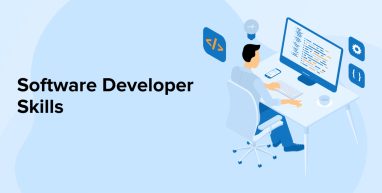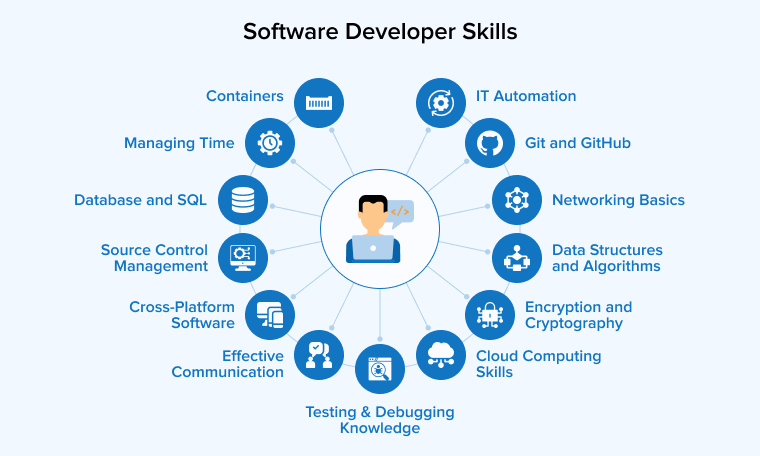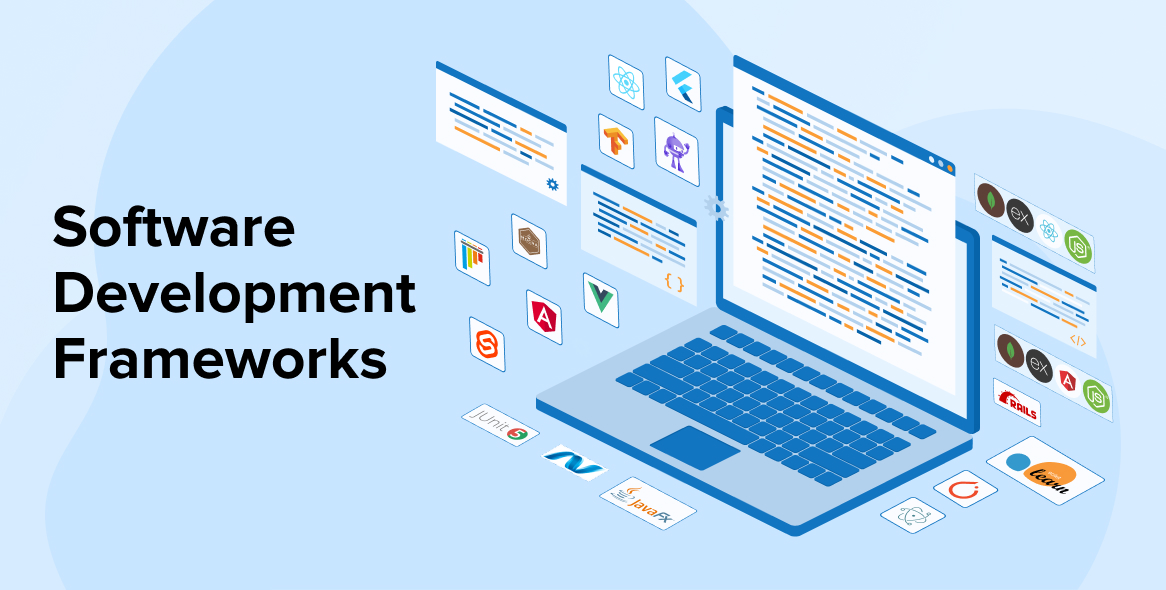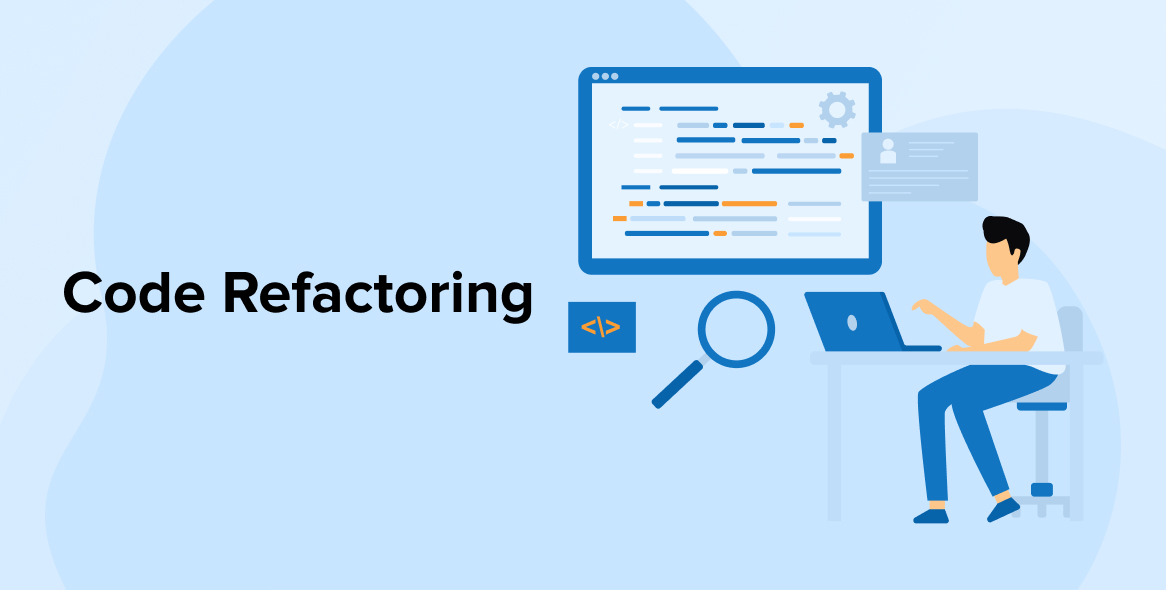
It is a known fact that unique skill sets contribute differently to the journey of software developers. Every software developer must have a certain skill set for software development that will help them easily develop and deploy applications. They can also build software programs, configure hardware devices, manage data structures and algorithms, encryption, databases and SQL, communication, and much more using their technical software developer skills.
Does this software developer skills need special attention? Well, yes, there is a list that one must know being a software developer to develop excellent software solutions. In this journey of software development, skillsets play a major role. Developers do have a checklist that is universally accepted and the majority of software developers silently follow this list.
This blog is for businesses who are trying to hire software developers based on their technical skills, or even for the software developers who want to know which software developer skills can make them better performers. So, let’s start with some of the prominent traits in software development services that would suit the needs of business and enhance the performance metrics of individuals.
To start with, we will be discussing all the essential concepts and software developer skills that will be helpful for software engineers.
1. Software Developer Skills

Following are the software developer skills:
1.1 Cloud Computing Skills (AWS, GCP, or Azure)
Apart from all other technologies, Cloud is every software developer and data scientist’s go-to technology. The reasons are quite simple for one to be familiar with cloud technology. It is because the cloud is the latest trending technology with easy-to-use guidelines and convenience added in 2022. Because businesses of all sizes and industries are moving their environments to the cloud for cost savings and improved scalability, developers will eventually need to deal with cloud-native applications.
The following three categories of cloud services exist:
- Services for software (SaaS)- Apps/devices that host services and offer access to corporate applications on demand.
- Service-based platforms (PaaS)-These include web-based services and cloud-based application deployment.
- Service-based infrastructure (IaaS)-These are online computing resources that have been virtualized; they frequently provide storage.
Cloud services for many firms is the lack of requirement as this requires them to purchase and maintain their own physical technology devices, software, storage, and infrastructure.
There are a small number of significant public cloud service providers (CSPs) and their offerings presently available for businesses. This will help them to have access to the majority of the cloud computing market. This includes giant names such as AWS, Google Cloud Platform (GCP), and Microsoft Azure are a few examples. Many customers can receive the same service from these suppliers. These ones will put them one step ahead of their rivals.
1.2 Data Structures and Algorithms
While algorithms explain the procedures used to carry out tasks, data structures are organizational strategies that work in favor of storing information in the form of a database. When deciding which algorithms and data structures to use together, he/she needs to optimize the information in a program’s code, so that it is easy for software developers to frequently possess a broad knowledge of algorithms and datasets.
From the start of their careers, software developers seem to frequently struggle to comprehend the significance of data structures and algorithms. However, as they progress and their career develops, they’ll come to understand how crucial it is when their code begins consuming excessive amounts of time or system memory. And it is very important to have software development skills that will amplify the process of software development life cycle.
A finished array structure for the databases can be easily used, for example, it might be used to hold various permutations of the same kind of information, like font data for a writing application or a font style. Users can have a variety of options to select a font’s type and size if the developer applied the right algorithm.
When developers use data structure, they must keep improving their knowledge of data structures and algorithms like they must be aware of tree type graphs, linked lists, and arrays. Because they are an essential component of every software development process.
1.3 Git and GitHub
Another skill expected from software developers is to have understanding of Git and GitHub tools and technology. Software developers can collaborate on projects on GitHub by sharing them with other programmers and developers. Users can contribute code in this way, and they can also assist one another in enhancing their projects. Programming languages of web development are also a vital part of software developer skills.
Users may more easily establish and manage their software development workflows with the help of GitHub’s numerous capabilities. Creating private repositories, keeping track of historical modifications, leveraging GitHub problems, monitoring project time, and other features are some of these.
He must be knowledgeable with version control solutions like Git and SVN if he works as a software developer. The market has been greatly simplified by Git and GitHub. Git is employed by major scale businesses. Hence, if someone is investing, make sure he/she invests some time in studying the command line, the GUI, and sophisticated version control concepts like branching and merging when learning Git.
Here the team is fond of regularly using source-control Git, other professional technologies, and practicing agile development methods.
1.4 Containers (Docker and Kubernetes)
The knowledge about containers is another essential aspect that can make a difference for many businesses. It is now established that containers like Docker make the deployment process simpler in addition to assisting developers in testing their applications in a unified environment.
In order to provide software in containers, Docker is a collection of Platform-as-a-Service (PaaS) solutions. For creating, distributing, and executing containers, a lot of people use the platform and tool known as Docker. An efficient way to manage large-scale clusters of nodes in production is to coordinate them with Kubernetes, a container orchestration system for Docker containers.
Compared to virtual servers, container – based apps use a lot less memory, start up and shut down much faster, and can even be crammed into their host hardware much more tightly.
Developers can easily deploy their application and all of its dependencies using Docker, which also offers process separation. Similar to this, Kubernetes, a platform for container orchestration, takes it a step further by managing containers on their behalf.
As a result, developers don’t need to worry about their application’s scalability because Kubernetes can take care of that automatically. Start learning Docker and Kubernetes; they’ll be useful not just in your current position but also in the one you’ll be applying for next.
1.5 Source Control Management
The term “source control management” aka SCM refers to a tool that the software development team uses to keep track of updates and coding language modifications. It gives each developer the chance to work on the code separately before combining their efforts into one version. SCM systems can produce a list of code revisions. And if necessary, they can assist developers in reverting a language to a former state. As businesses frequently demand software developers to work in teams on the same coding projects, it may be beneficial to understand how to use a specific sort of SCM system.
Tracking source code alterations is known as source code management. Programmers, developers, and testers may make sure they’re constantly working with accurate, up-to-date code by keeping a running history of the changes made to a codebase. This also helps to resolve issues when integrating code from different sources.
Due to the fact that several developers frequently collaborate on the same codebase, source code management is crucial. Additionally, while each developer worked on a different feature, they ran the risk of unintentionally altering the same code, or the modifications made by one developer could be overwritten by the changes made by the other developer.
There weren’t many protections against these situations prior to the introduction of source code management. To prevent any confusion, each developer had to inform the others whenever they began working on a new file.
To keep a single source of truth for development teams, source control is crucial. Its use promotes collaboration and quickens the rate of release. Among the advantages of source control are:
- It enables several developers to collaborate on the same codebase.
- There are no conflicts when developers commit and merge code.
- Developers can make changes to shared code without accidentally overwriting one another’s work.
1.6 Networking Basics
Developers use the client-server model in the majority of scenarios. This is because it allows users to access applications from anywhere on the globe. All one needs is a network and they are halfway done. When they use this approach, a request is routed from the network to a server. For developers to create and maintain an application, a fundamental understanding of networking is necessary.
A network-based HTTP request issue might arise if the architecture is improperly built. In a client-server architecture, a user or client sends a POST request over the internet, which is received by the server. The server then processes the request for data and sends the client’s answer. Majority of apps nowadays use client-server architecture. Therefore, it is impossible to dispute the importance of networking principles and basics.
1.7 Testing & Debugging Knowledge
Before a business releases a piece of software to users, it must go through a rigorous testing process. It entails employing a variety of digital technologies to check that a product works and adheres to its design specifications. Additionally, it requires verifying a program’s capacity to hold sensitive data and run on various hardware platforms. Before applying for work roles, it may be beneficial for a software engineer to comprehend fundamental concepts since businesses frequently build their testing methods on a few key components.
Developers are aware of the following four aspects of software testing:
1. Unit Testing
This testing entails examining certain lines of code or sections of code to see if they need to be modified. For each project they complete, developers frequently produce a unique unit test to make sure they’re developing the project without any bugs.
2. Integration Testing
Integration testing allows software engineers to use testing to assess their ability to correctly combine various sections of a program’s code. They can use integration testing to watch how the code of one software program communicates with that of another.
3. System Testing
This testing is usually carried out by an outside testing expert once integration testing is finished to ascertain whether a product meets user expectations. Software developers should be aware of each phase in this process because testing experts frequently offer crucial suggestions for changes.
4. Debugging
It is a procedure in software development to identify and fix coding flaws in programming languages. It entails running a program through specialized software to identify each error, then utilizing problem-solving abilities to identify which line of code caused it to occur. To better assure that their code will work during testing, many software developers debug it as they write it. It’s crucial to learn how to use debugging software so they can discover key methods for eradicating faults and creating efficient procedures.
Further Reading on Software Testing:
What Are The Types Software Testing?
QA Best Practices for Software Testing
1.8 Encryption and Cryptography
It is crucial for a developer to build a secure and encrypted key to stop any assaults when creating software or online applications that employ sensitive information from a user. When it comes to creating a product or piece of software, security of sensitive user data and preventing site hacking are the top priorities for every organisation. An understanding of how cryptography techniques, authentication algorithms, and encryption algorithms operate is expected of a developer.
For data encryption, there are primarily two techniques. These are the private key and the public key. A key is created using public key encryption techniques like RSA or ECDSA. The developer can decide which one to use based on their preference for the network’s overall security. In order to create a safe system, secure database, and to provide secure output across the network after processing the request, a developer uses cryptography. It also helps secure error handling and enables the usage of third-party libraries without concern for security issues.
The most popular technology called Cryptography is a technique for hiding sensitive data. The confidentiality of data can be done using an encryption code or a password, often known as a key. It entails creating a similar decryption code using an algorithmic method so that a user may see the original data. To stop outsiders from understanding details about a product, software engineers frequently employ encryption techniques. Asymmetric encryption, which requires two keys to decrypt the original material, and symmetric encryption, which only requires one key, are the two main types of cryptography to study.
1.9 Database and SQL
Knowing how to work with databases is a crucial ability for developers. The ability to create, insert, update, remove, and other operations should be known by developers. Without a database, no organisation can produce any form of software or application. Every organisation expects a developer who is comfortable using databases and securely managing all records when they work on a serious business project. This is because when a developer manages any serious business project, they also need to take care of security issues and manage all organisation records with proper backup. SQL is without a doubt the most widely used traditional database among developers.
Supporting the fact that there are numerous databases, like MySQL, Microsoft SQL Server, Oracle, PostgreSQL, and others. But for developers, mastering just one is more than sufficient. They must be familiar with the database, and that is a crucial factor. They ought to be familiar with writing SQL queries to get data as well as inserting, updating, and deleting information.
1.10 IT Automation
The use of software to generate repeatable procedures and instructions to replace or minimize human contact with IT systems is known as IT automation, or infrastructure automation. With little to no human intervention, automation software completes the activities by working within the constraints of those directives, resources, and frameworks.
To optimize IT and shift to a digital economy, automation is essential. In order to scale more quickly than ever in today’s dynamic IT environments, IT automation is essential.
It is possible to automate a work to some extent if it involves IT, in theory. Consequently, automation can apply to and integrate with anything. It includes network automation, infrastructure, cloud provisioning, and standard operating environments (SOEs), as well as application deployment.
1.11 Cross-Platform Software
Software that can run on different operating systems, such as Windows, Mac, and Linux is known as cross-platform software. The ability to write code once and distribute it across multiple platforms is known as cross platform. Because the majority of customers are now switching to mobile devices or smartphones to use the product or services, it is critical for a developer to create a product that can be used by the widest possible range of systems. When the programme is optimised for the largest number of devices, the number of consumers can gradually expand. If someone wants to advance their career as a programmer, whether they’re just starting out or have some expertise, they should be familiar with working with cross-platform
1.12 Effective Communication
For software engineers to have knowledge of programming language is important but communication is where many software engineers fail. Thus, it is necessary to be able to communicate clearly with non-technical team members, solicit assistance when necessary, and allocate tasks in a way that encourages team members to feel appreciated and invested in their job.
It is crucial to have effective cross-department communication, especially while working remotely and even otherwise. Learn how to network with other software engineers to enhance their communication skills by taking their own time while also enhancing their professional brand.
1.13 Managing Time
For every tech company, they look for both the software developer skills like tech skills as well as behavioral skills. So, other than software engineering skills, this skill holds equal importance when it comes to managing time. Time management turns out to be an essential software engineer skill that is not taught but is self-imbibed in engineers. This helps them to meet deadlines, software managers must be able to keep their teams on task.
Members of different software development teams who are based in separate time zones might have common issues with time zones. Thus, managing time and balancing it with engineers and management located at other locations is another essential aspect of handling many moving pieces within a limited span of time whilst meeting deadlines.
2. Conclusion
At the end of this insightful blog, our real intent was to educate demanding companies with software developers skills. For companies who are willing to hire software developers and also the naïve software developers who are not sure of which skills to learn in order to become a performer in their own space, this one will guide them through. From this blog, we thought of advocating the right software developer skills required and how each of these will make a difference in developers’ career graphs. These allow businesses to make the most from their hired resources. The selection process helps you gauge the real software developer skills before hiring. It will also prevent any further consequences occurring due to lack of resource knowledge and proficiency.






Comments
Leave a message...